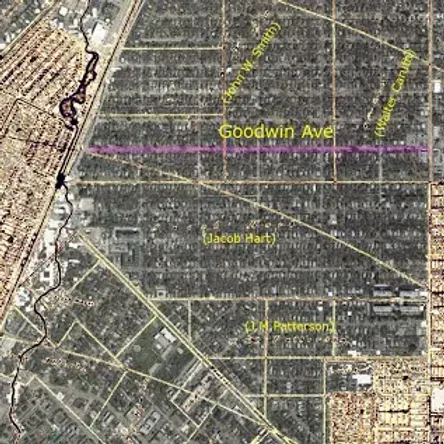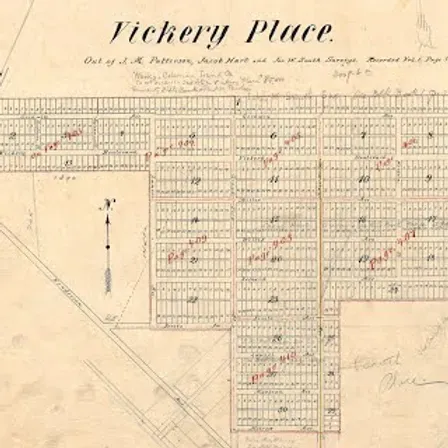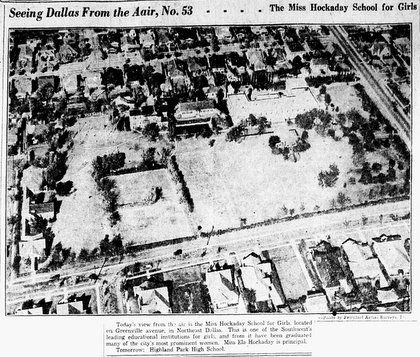History

In the early 1900's Vickery Place was mostly cotton fields, and was considered North Dallas, with Goodwin Avenue the northern city limit. With the introduction of street cars in 1888, people began to move outward from the city. Platted in the year 1911, Vickery Place is one of the oldest suburbs in Dallas. Vickery Place was developed by the Works‑Coleman Land Company. The Land Company was directed by R. Vickery, J.E. Coleman, Osce Goodwin, George W. Works, and J. Houston Miller, with many streets now bearing their names.
Before Vickery Place was platted, the area consisted of farmland as can be seen in this interesting overlay of an 1891 Dallas Map on a modern aerial photograph. The northernmost street of Vickery Place is Goodwin Avenue, which is shown on the map highlighted in purple. The original farm boundaries of John W Smith, Jacob Hart, Walter Caruth and J.M.Patterson's lands may be seen on this map.

Below is the original survey of the farms of J.M.Patterson, Jacob Hart and John W Smith, recorded on August 12th, 1911. The annotations on the survey are fascinating! On the left is the H&TC Rail Road, which would one day become US-75 (Central). On the right, modern day Greenville Avenue is labeled as "Richardson Pike Ross Ave Extension". Henderson and Knox are still separated, and the area currently occupied by Vickery Towers has the annotation "Caruth Place". The street names are also quite different south of Bonita. There is no Belmont Ave, which is instead labeled as "Laurel Ave". Likewise the current Richmond Ave is labeled "Marbrau Ave", but Melrose Avenue has retained its name. The current Vickery Place is bounded on the South by Belmont, so it is certainly interesting to see this first old survey that tells a different story. Some more research on the web tells us that "Marbrau Ave" was changed to "Richmond Ave" in 1933-1934. Another surprise is that Glencoe used to be called "Grand View". That name change also happened in 1933-1934. The 500 lots shown here commanded the lofty sum of $85,000. In 2007 dollars, that is $1.87 million, or about or just over $3,700 per lot! A great deal!

As Vickery Place developed, so did the relationship between R. Vickery's daughter, Lillian and George W. Works. The home at 5605 Vickery was built for George W. Works and his wife Lillian. A few years later, he built a duplicate house at 5435 Vickery, with minor modifications. Interestingly, Mr. Works was also the Secretary and manager of the Dallas Street Railway, and used this resource to help convince people to move to Vickery Place through advertising on the back of his street car transfer tickets.
A snippet from the Dallas Morning News (July 8th, 1911), indicates that Vickery Place was in demand (as it is now!), with 200 lots being purchased by about 150 people, who "intend building at once."

Here is a newspaper advertisement from 1913. The princely sum of $800 is roughly equivalent to $17,000 in 2007 dollars. This price was for the lots, only.

By 1921, construction within Vickery Place was proceeding at a blistering pace. In this November 20, 1921 article from the Dallas Morning News, there is a lot of information! The Vickery Place Boosters Club (the precursor to the VPNA) was instrumental in developing the neighborhood. By this time, most of community was not paved. There were also plans to extend Vickery Place by some 25 acres on the West Side (the part of present day Vickery Place West of Laneri), all the way to Carmen Street. Where is Carmen Street, you may ask? On old maps, it is the frontage road running by the H & TC railroad tracks, where Central Expressway is now. The old school building, at McMillan and Miller, was bursting at the seams, and it would be a priority of the community to build a new school building a few years later, in 1923. This new school would be called the Vickery Place School, which would much later become the present day James B. Bonham Elementary School.


On June 14th, 1931, the drawing below appeared in the Dallas Morning News, announcing plans for a new modern store building at the corner of Greenville Ave and Goodwin Ave at the cost of $25,000. That is approximately $300,000 in 2007 dollars, after adjusting for inflation! We sure seemed to get more for our money in the old days! This was to house six large store-rooms "designed in the latest style". Today, this building is a little smaller than the depiction in the drawing, and houses four bars and restaurants. The Greenville Bar and Grill was one of the first tenants, opening in 1933 as one of the first places in Dallas operating with a beer license after Prohibition. Other stores in the building included a dry cleaner, a five-and-dime, and a drugstore with a soda fountain. During the 30's and 40's, before the construction of the Central Expressway, much of the traffic between Dallas and Oklahoma passed through Greenville, and the Greenville Bar and Grill was a popular spot for those attending the annual Texas-Oklahoma football game.

Talking of shopping, and Lower Greenville... Back in 1931, Lower Greenville was one of the best places in Dallas for all kinds of shopping and restaurants, and even a movie theater! Alas, the Arcadia burned down in recent years, but Lower Greenville is still one of the hottest entertainment districts in Dallas. Here is an aerial view of Lowest Greenville (South of Belmont), part of a wonderful series called "Seeing Dallas From the air" run in the Dallas Morning News, in December 1931.

Significant Buildings
In 1923, Reverend W. M. Williams and L. B. Haskins built the Greenville Ave. Christian Church. This three story structure at the 2700 block of Greenville Ave. was built at the cost of $60,000. The congregation began with 75 members and reached its peak in 1945 with 1,200 members. Due to post war suburban migration and the aging congregation, the church had a final service on August 29, 1982. In the early 1990's Vickery Place lost this wonderful piece of history to fire.
In 1922 North Dallas High School opened. Today the building remains as an outstanding piece of architecture with many unique features. The school's staff included, a history teacher‑coach, E. D. Walker, the father of football star Doak Walker. Many students went on to be prominent figures in Dallas, including Rufus Burleson IV, founder of Baylor Hospital, State Representative and Mayor Earl Cabel, Judge Barefoot Sanders , the Cullen family (founders of Tom Thumb), "Little Anthony" a singer in the 60's, columnist Bob St. John and Pulitzer Prize winner James Dickman. Although, as of 2012, Vickery Place no longer feeds into North Dallas High School, the building remains as an enduring reminder of the history of the area.
However, of all the schools in Dallas, the most prominent was Miss Hockaday's School for Girls.

It was established in 1913 and moved to Vickery Place in 1919 with a campus at the corner of Belmont and Greenville Ave., where the current Vickery Towers sits today. Hockaday School, founded by Ms. Ela Hockaday, was established with the vision of giving young women knowledge, culture, courage and high moral standards. By 1928 the school had acquired a national reputation for their academic achievements. In the 1960's the school relocated to north Dallas but still carries on the dreams established by Ms. Hockaday. The original campus in Vickery Place is now a home for assisted living, Vickery Towers. Many of the surrounding homes of Vickery Place was built for the teachers of Hockaday; the home at 5552 Belmont is one such home.
The former Hockaday Campus is seen in this two additional aerial photographs, one of which is from the same Dallas Morning News "Seeing Dallas From the Air" series referenced above. Sadly, none of the original buildings remain today.


Transportation
Railways, streetcars, and model T’s were the means of transportation for residents of Vickery Place. The Houston and Texas Central Railroad, now Central Expressway, formed the western boundary of the platted neighborhood. In 1927, where the H&TC railroad traveled Central Boulevard Expressway was proposed. Construction began on the project twenty years later in 1947, pushed by J. G. Rollins, Dallas’ Director of Public Works. Reconstructed Central Expressway was completely rebuilt.
The following aerial photo is of the entire Lower Greenville Avenue area, reportedly taken in October, 1930.

The North Central Expressway was constructed in 1950 (or 1953, depending on what "completion" means), and replaced the railway tracks that defined the western boundary of Vickery Place. In the photo below, there is an aerial view of the new highway looking south at Walnut Hill. Greenville avenue can be seen coming in at an angle from the left, and then turning at present day "Lovers Lane". In the distance you can see the lush vegetation of Vickery Place to the West of Greenville Avenue. Unfortunately, this new marvelous highway (and Dallas' first) was unable to cope with the phenomenonal expansion that Dallas saw through the next 50 years, and so the highway was reconstructed between 1992 and 1999. The reconstructed highway is one of the most attractive urban freeways, and sits almost 30 feet below the adjacent frontage roads that form the Western boundary of Vickery Place, further enhancing the urban serenity of our neighborhood.

The McMillan Avenue Streetcar ran parallel, to Central, four blocks to the east. The Streetcar ran from Ross Avenue and ended at Vickery Blvd. This electric line was used until the late 1930's. George Works one of the founding fathers of Vickery Place was the Secretary and Manager of the Dallas Street Railway.
One block east of Greenville Avenue, where Matilda Street is, ran the Interurban Lines, that served Richardson and extended as far north as Denison. This line was discontinued in the fifties. Greenville Avenue was a part of the Federal Highway system, U.S. 75, and always functioned as the commercial center of the neighborhood.
James B Bonham Elementary
James B. Bonham Elementary School, an historic East Dallas School, located at 2617 N. Henderson Avenue, was originally the Vickery Place School. The building was constructed in 1923 and cost approximately $121,000 to build. The architect was well known architect C.D. Hill. In December of 1939, the school board decided to change the name to James B. Bonham School. We believe this was done to avoid confusion with the town of Vickery, which was annexed into DISD soon afterwards. It is the opinion of some architects that the building is historically important to the City of Dallas and that any future renovation work be done in a manner which would preserve the original design characteristics. In 1923-24, there were 885 teachers in DISD and 36,000 students.
The current location of the school is actually the third physical location of the Vickery Place School. In 1923-24, the new Vickery Place School was built at 2617 N. Henderson (VP school was previously located at the corner of McMillan & Miller and before that at 5330 Goodwin Avenue). The name of the school changed in 1939 to James B. Bonham School. (from DISD School Board Minutes, Vol. 26, pg. 197, Dec. 16, 1939: “Board voted to change the name to James B. Bonham”). The original locations of the Vickery Place School are still standing.
The architect of the Bonham Elementary school building is C.D.Hill, one of Dallas' most prominent early architects. C.D. Hill also was the architect for the Alexander Mansion (Dallas Women's Forum) on Ross, several houses in Munger Place and on Swiss, and he designed the Municipal Building (the new UNT law school) downtown, among others.
James Butler Bonham died at the Battle of the Alamo during the Texas Revolution. Read more in the Wikipedia article.
On January 26th, 2012, the DISD Board of Trustees voted to close James B Bonham Elementary School.
From the Dallas Morning News Archives, July 2, 1923:





Comments ()